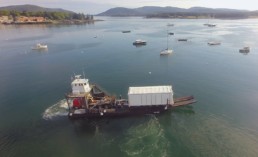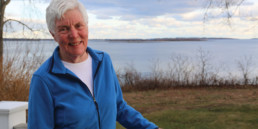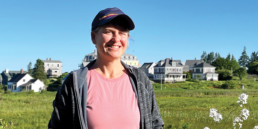Carving Out Funds for Island Affordable Housing
By Tom Groening
For a divorced mother of a five-year-old, moving to the island was a kind of retreat and a kind of homecoming. Except there was no home.
Maggy Willcox, who today publishes the Islesboro Island News, grew up in nearby Rockport in the early 1960s, and remembers the small-town nature of the community. It was the kind of town where mothers would send their kids out the door on a summer morning and not expect to see them again until lunchtime.
So in 1990 when she found herself alone with her child, the idea of spending the summer on Islesboro was appealing.
“I just needed a change of scene,” she recalled, and the island was “very much like” the small town of Rockport. “As a newly single mother, that looked very attractive. I thought, ‘Okay, that’s a good place to spend the summer.’ ”
She took a job at the food truck that operates seasonally at the ferry landing.
“It was a step back in time. It was magical,” she said, and decided to stay through the winter. Her first place was “lit-tle more than a camp. It was two rooms, not really winter-ized, and had an outhouse, where the infamous up-island spiders would hang out. You’d bang on the door before going in.”
After that, home was a summer resident’s place, also not winterized. She stayed in exchange for working on the house.
“There were always these strange little deals you could work out,” she recalled.
Enrolling her son in the island’s highly rated school made her want to find a more permanent deal. The Isles-boro Affordable Property group had formed in the early 1990s, and had completed a housing needs study and landed funding. Its first project was an eight-unit subdivi-sion on 13 acres that had been sold at a discount by the late resident Ruthie James.
“I was one of many applicants,” Willcox said, but she was chosen. The houses were designed to be owner-built, with materials precut and labeled, so “Tab A would go into Slot B.” Those selected for the houses were supposed to work together to build them, and finish them in 28 weekends.
“None of that happened,” she said. The blueprints were minimal, and as one family’s house was finished, they con-centrated on its own interior work—understandable, Will-cox said—and couldn’t stay with the building team. The housing group’s executive director quit abruptly in the middle of the project.
By this time, Willcox was working at the post office. People would routinely offer to help work on the house on the weekend, but few turned up. Chuck Whitehouse, now deceased, offered and came through.
“He spent a year and a half with me on weekends,” she said. “It was the most Christian act I have ever seen in my life.”
Her ex-husband and many others took on specific proj-ects; the island-based Central Maine Power representa-tive “took scraps from the boards we used for walls and made me custom kitchen cabinets. I baked a lot then, and he even built a tip-out bin for my forty-pound bags of flour and sugar.”
Still, there were bad moments.
“I remember sitting on my roof, nailing in boards, and sobbing,” she recalled.
It’s no wonder the island affordable housing group now buys modular homes.
The story has a happy ending, though. The home she now shares with her husband, Peter, a boat captain for the environmental activist group Greenpeace, is eye-pleasing with its steep pitched roof, and comfortable, with a soaring living-room ceiling balanced by an efficient galley kitchen. At 1,172 square feet, “It’s what the real estate people call cozy,” Willcox joked.
Exposed studs and sheathing planks create a warm effect, while the rigid foam insulation attached outside the sheathing means it heats easily.
Through a land-lease agreement, Willcox pays Isles-boro Affordable Property just under $100 month. The nonprofit owns the land and the shared wells and septic systems. Mortgage payments are in the $500 to $700 range for most, she said. If a house is sold, the home builder gets $5,000 back for the “sweat equity,” plus a percentage of the value of whatever improvements have been made (porches, decks, etc.).
Her son Sky graduated from the school—one in a class of three—so the happy ending was complete. “I’m so glad I made that commitment,” Willcox said, which made his education there possible.
These days, affordable housing includes both public efforts and a more informal, island network, Willcox said. Three of the original eight remain in the subdivision; the other five have moved off-island, she said, adding, “You come here and you appear to be useful, people will go the extra mile and find you a place.”

Carving Out Funds for Island Affordable Housing
“Affordable” housing has a different meaning on the islands. Thanks to their desirability for seasonal homes and the finite land available, real estate costs are significantly higher than on the mainland.
Explaining that reality to legislators who were crafting a bond aimed at helping towns build affordable houses wasn’t easy, though. Genesis Community Loan Fund and the Island Institute were able to do so, and as a result, a $30 million bond package approved by Maine voters in 2010 included $2 million devoted to building affordable rental housing on year-round islands.
The rules for distributing the housing funds were crafted “for the needs of rural communities through flexible standards,” remembers Greg Payne, director of the Maine Affordable Housing Coalition. Those standards were written with islands in mind, he said.
Affordable housing initiatives typically target communities with lower median incomes, Payne said. Fishermen on islands would be ineligible under those standards, however, because some of those communities have high median incomes.
The rules for grant awards took island income into consideration, as well as the smaller scale of island projects; fewer units were built, which was less efficient, but made sense in small island towns, Payne said.
Construction costs are significantly higher on islands, too, a wrinkle that normally would have had legislators leaning away from such high-cost, low-return projects. Fortunately, significant lobbying of legislators persuaded them to understand and accept the island-specific challenges.
“The Island Institute had a big role in making a great success of the subset of this bond,” Payne said. He also credited Liza Fleming-Ives of Genesis.
Rental units were chosen over ownership to provide essential workforce housing, he said.
The island units built through the bond included six on Vinalhaven and two each on North Haven, Islesboro, Chebeague, Peaks, Isle au Haut, and Great Cranberry islands.






